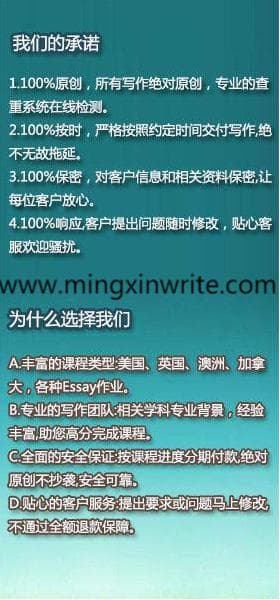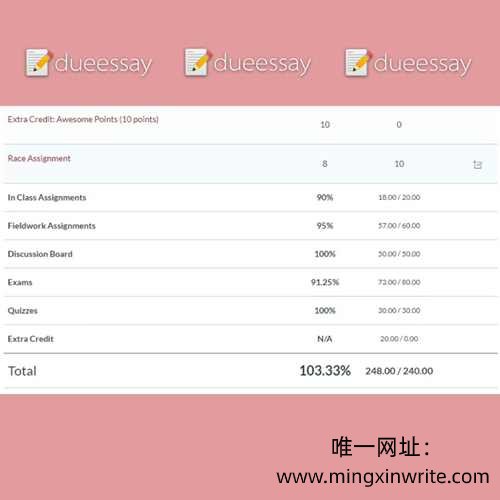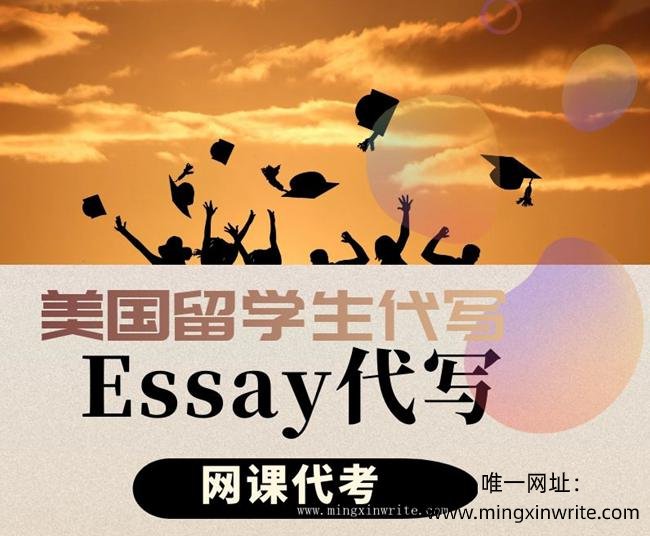发布时间:2021-07-20 热度:
DueEssay是提供留学生代写,Assignment代写,Exam代考,Report代写,保证100%原创,准时提交高质MLA格式,apa格式,哈佛格式英文论文代写,essay代写价格透明,老牌Essay代写推荐,论文作业代写服务机构。留学生论文网专业提供代写留学作业,代写essay,代写assignment,CS代写,Termpaper代写、Course代写,澳大利亚essay代写,会计学、管理学,社会学、统计学,生物、化学、商业,物理学、生理学、政治学、项目管理学,物业学、心理学等。
英国、澳洲、美国留学生essay report dissertation论文报告个性化指导定制,论文查重校对,轻松拿高分读名校,顺利毕业进名企。提供essay代写、代写essay、英文essay服务
这是我们在2017年为美国波士顿大学学弟创作的一篇Art history代写范文,首先开头部分通过introduction介绍了文章的背景信息,文章认为将中国绘画与其他绘画区分开来的最鲜明特征之一是绘画上的铭文。例如,在赵孟俯的绵羊和山羊中,铭文和绘画在作品中几乎占有相同的比例,铭文之所以出现在中国画上的原因是因为中国人认为书法和书画总是紧密相连的。
One of the most distinctive characteristics that differentiates Chinese painting from other paintings can be the inscriptions on the paintings. For example, in Zhao Mengfu’s Sheep and Goat, inscriptions and painting almost take up equal proportion in the work, which does look “cluttered to Western viewers” (Kleiner, 1051). As Kleiner points out, the reason why inscriptions usually appear on Chinese painting is because “the Chinese have held calligraphy in high esteem” and “calligraphy and painting have always been closely connected” (Kleiner, 1051).
接下来的body部分的讨论,提出加入题画的传统可以追溯到唐代。一开始铭文的主要目的是为了表明艺术家。因此,在早期的中国绘画中,尤其是宋代的艺术作品,碑文通常是艺术家的名字。例如,在范宽的“山川流水”中,铭文仅仅是一个小角落里的艺术家 – 也即是“范宽”的名字。

The tradition of adding inscriptions on painting can trace back to the Tang Dynasty. ,However, in the beginning, the main purpose of inscription was to indicate the artist. Therefore, in the earlier Chinese painting, say art works from the Song Dynasty, the inscriptions were usually the name of the artists. For example, in Fan Kuan’s Travelers among Mountains and Streams (Song Dynasty), the inscription is merely the name of the artist – “Fan Kuan” in a small corner (Yu, 85). Starting from Yuan and Ming Dynasty, Chinese literati and artists were required to perfect their abilities of both painting and writing calligraphy. As a result, the inscription on painting has begun to play a more and more important role and the content of inscriptions has been expanded – it can include the information of the creator, such as his/her name, age and title and it can also include the information where and when the art word was made. More interestingly, Chinese literati and artists even started writing poets on the painting, which can be found in some Song art works but were very commonly seen in Ming and Qing art works: since Northern Sung Dynasty, “poet-calligraphers, such as Su Shih, Huang T’ing-chien, and Mifu started to write out their works in large character handscrolls for presentation to friends or political associates” (Harrist, 1).
在文章的最后也就是conclusion的部分提出总结,认为对于中国文人来说,绘画并不是表达自己的唯一方式,这一点与西方艺术不同。中国书法被视为具有审美维度并能反映创作者思想感情的主要艺术形式。除书法之外,诗歌在文人的生活中也同样扮演着重要的角色。
For Chinese literati, painting is not the only way to express themselves: unlike Western art, Chinese calligraphy is regarded as a major art form which has the aesthetic dimension and can reflect the thoughts and feelings of the creators. Besides calligraphy, poetry plays significant role in literati’s life and like painting and calligraphy, Chinese literati usually took advantage of poetry to express themselves. And according to Kleiner, for those Chinese literati: “poems provided subjects for paintings and poets composed poems inspired by paintings” (Kleiner, 1051). In tradition Chinese culture, “it is common knowledge that Chinese poetry, calligraphy, and painting, have been practiced together in single works of art” (Fong & Murck, xv). Therefore, it is not difficult to understand why some Chinese paintings are full of inscriptions and also it is necessary for the viewers to appreciate both the painting and inscriptions in order to fully comprehend the art work.








